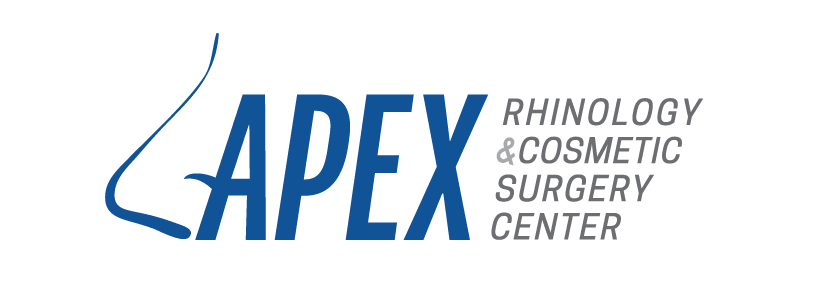Rhinoplasty, one of the most common cosmetic surgeries in the world, works to reshape the nose, improve breathing, or both. Also known as a “nose job,” the procedure can play a big role in enhancing a person’s facial appearance or correcting nasal function.
Just as no two noses are alike, neither is rhinoplasty the same for everyone. The procedure is tailored to your specific needs in consultation with your surgeon. At Apex Rhinology & Cosmetic Surgery, we take great care to understand your goals and work with you to create a personalized treatment plan.
Enhancing Facial Appearance
The nose is a defining facial feature. If you feel the size or shape of your nose throws off your facial balance or proportions, even a subtle change can greatly improve appearance by balancing your features. With rhinoplasty, we can improve:
- The size of your nose in proportion to your face
- Bridge width
- Nostril size and position
- Visible bridge bumps or depressions
- A nasal tip that affects facial harmony — for example, enlarged, hooked, or drooping
- Large, wide, upturned, or asymmetrical nostrils
Most important, treatment revolves around your unique needs. Our preoperative assessments with 3D computer analysis (VECTRA® H2) help facilitate a comprehensive discussion of your goals — and the best ways to achieve them — prior to surgery.
Correcting Nasal Functioning
If birth deformities, injuries, allergies, or a virus result in obstructed breathing, surgery can help clear the nasal pathways so that breathing is easier. Nose surgery can improve or alleviate a number of conditions that make breathing difficult, including:
- Deviated septum
- Overgrowth of tissues that line the inside of the nasal passages
- Aging
- Broken nose
- Swelling that blocks the nasal passages
Millions of Americans suffer from chronic nasal stuffiness. Blockages that don’t respond to simpler treatments, such as nasal decongestants, may be best alleviated through surgery.
Surgery is the only fully effective treatment for a deviated septum because it’s a structural condition: The septum — the partition between the nostrils — becomes crooked or bent because of an abnormal growth or injury and completely closes one or both nasal passages.
A deviated septum can be corrected with a septoplasty, which reshapes the septum and allows for enhanced airflow. Cosmetic changes may be performed at the same time, if the patient requests, or if the physician suggests that it would further improve breathing.
During a septoplasty, the skin around the nose is lifted as the surgeon removes or rearranges bone and cartilage to reshape the nose. The skin is then draped across the new frame of the nose, while a nasal splint is placed on the outside of the nose to help retain shape during healing.
Occasionally, absorbent material is placed inside the nose to stabilize the septum during healing. These materials, along with other nasal dressings and splints, are removed within five to seven days after surgery. Risk factors are generally minor.
If you’re wondering whether rhinoplasty is the right solution for you, our experienced team can answer your questions, address any concerns, and discuss the steps appropriate for your specific needs. We’re committed to helping you look, feel, and live your best, so don’t delay. Contact Apex Rhinology & Cosmetic Surgery to schedule your consultation today.
Frequently Asked Questions
Am I a good candidate for rhinoplasty?
Skin type, ethnic background, and age are among the factors considered for surgery. Except in cases where there’s a severe breathing impairment, children younger than 15 or 16 usually aren’t candidates for nose surgery. At your initial consultation, we’ll discuss the cosmetic changes you want, the techniques available, and your level of commitment to the aftercare requirements that help ensure success. Smoking or certain medications, for example, can affect the surgery’s success.
Is rhinoplasty painful?
Rhinoplasty can be done under local or general anesthesia. We select the type of anesthesia based on the extent of the procedure and the patient’s wishes. Rhinoplasty itself as well as recovery are well tolerated in most patients and typically don’t require pain medications.
Are nose job results permanent?
Rhinoplasty results are permanent. As aging occurs, however, features are expected to change.
Is rhinoplasty safe?
Any surgical procedure has risks. As a practice committed to patient education and empowerment, we ensure risks are explained prior to surgery.
When can I wear my glasses after rhinoplasty?
You can wear your glasses immediately. The bridge of the glasses may need to be supported with a small piece of tape to keep the pressure from the nose and to help avoid interrupting the healing process.
When can I sleep on my side after rhinoplasty?
Initially you may feel more comfortable sleeping on your back. Within days after surgery, however, any position may be acceptable. Different people heal at different rates, thus your individual experience may differ from others’.
Will rhinoplasty change my voice?
Any airway surgery can potentially change the voice — just as a common cold or allergies can. It’s extremely unlikely, however. As with many other possible surgical risks, this would be discussed during an office consultation.
Can rhinoplasty help snoring?
Changing the shape of your nose usually doesn’t help with snoring. Frequently, however, a septoplasty is performed at the same time as your rhinoplasty. Improving your nasal airway can help decrease or eliminate snoring. Sleep disorders such as snoring should be addressed with your facial plastic surgeon before surgery.
